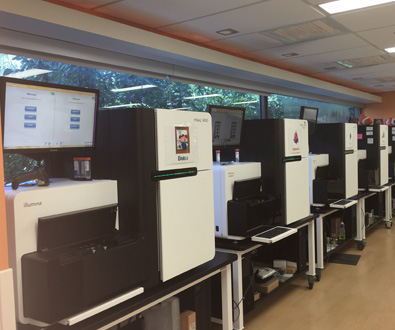
2016년 10월 17일
At the Center for Pediatric Genomic Medicine at Children’s Mercy Kansas City, the laboratory team is on the leading edge of genomic research. Tools in their arsenal include a bevy of Illumina instruments each named after different characters from the movie “Finding Nemo.” The analogy is apt; just as Marlin, Nemo’s father, is faced with a seemingly impossible quest to find his way to Sydney to rescue his son, the laboratory team is often tasked with finding the genetic needle in the haystack. To do this, they use sequencing in clinical research studies aimed at developing new understandings of rare and undiagnosed genetic diseases and how they affect the health of study participants.
The laboratory recently started a new research project taking a broad “integrated genomics” approach to understanding what’s going on in these difficult to understand inherited disease cases. Integrated genomics is an approach combining numerous next-generation sequencing methods to understand the underlying biology of a given sample.
“Using whole-genome sequencing to study the genome can often help identify the genetic basis for disease, but sometimes it’s not enough information to figure out what’s going at a biological level,” said Emily Farrow, PhD, CGC, Laboratory Operations Director. “Sometimes there’s more to the story and we’re not seeing it if all we do is sequence the genome.”
To gather the additional information, new instrumentation was required and “Darla,” their new HiSeq 4000 System, joined the lab.
“We purchased the HiSeq 4000 for translational research projects, especially rare disease research,” said Margaret Gibson, MB, Lead NGS Technologist. “The speed was a large part of the appeal. We can do more in three days on the HiSeq 4000 than we can in six days using one of our older HiSeq 2500 models,” she added.
Integrated genomics is providing a deeper understanding of the biology and allowing deeper investigation of the relationship between DNA and inherited disease.
One thing they are looking at is methylation state. Methylation, usually referring to a heritable chemical tag on the DNA, tells a story at the molecular level. While many rare diseases are not methylation-related, methylation may be playing a role in the biological processes behind some rare conditions. Another method is examining the RNA that is expressed from genes to provide clues on what cells in the body are involved, as well as disease progression and severity. Combining whole-genome sequence data with these additional data may provide more opportunities for physicians to help these children.
The research started in early 2016. “We had been interested in this type of research for a while, but it was cost prohibitive to do until we got the HiSeq 4000 installed,” said Farrow.


